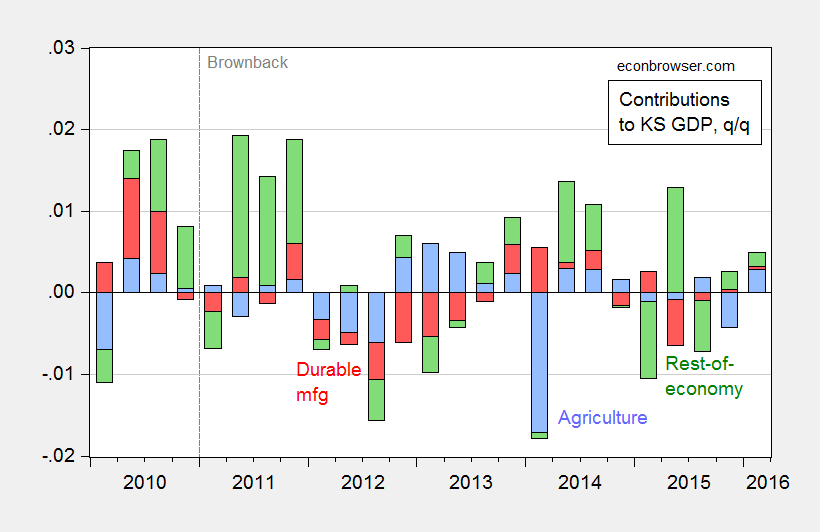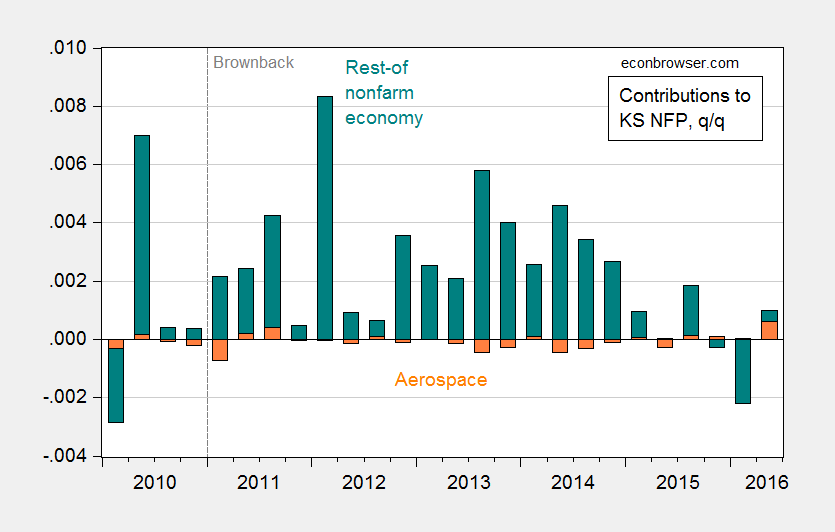Ironman at Political Calculations thinks so. Unfortunately, in his calculation of Kansas GDP excluding agriculture and manufacturing, he made an error by simply subtracting (chain weighted) real agricultural output and real manufacturing from real GDP (as discussed in the addendum to this post; note that Ironman has never to my knowledge acknowledged this error). I’ll re-examine the importance of the shocks to the aerospace industry in Kansas to the slow pace of Kansas growth by looking at contributions to GDP growth, and contributions to employment growth.
Figure 1 depicts a mechanical decomposition of Kansas real GDP growth into agriculture (blue bar), durable manufacturing (red bar), and rest-of-economy (green bar). I focus on durable manufacturing because this encompasses aerospace production the best.
Figure 1: Quarter on quarter (not annualized) contributions of agriculture (blue bar), durable manufacturing (red bar) and rest-of-economy (green bar) to overall Kansas GDP growth, in Ch.2009%. Source: BEA 2016Q1 2nd release, and author’s calculations.
Note that there was substantial drag on growth from the durable manufacturing sector in 2012-13, but that drag has mostly abated; hence we do not have a good explanation for why overall GDP growth has been so slow over the past year.
If we look to employment, one sees a similar pattern, although the drag occurs in 2013-14. By the last quarter of data, aerospace employment (orange bar) is adding to (admittedly lackluster) nonfarm payroll employment growth.
Figure 2: Quarter on quarter (not annualized) contributions of aerospace product and parts manufacturing (orange bar) and rest-of-nonfarm payroll employment (teal bar) to overall Kansas nonfarm payroll employment growth. Source: BLS June 2016 state level employment release, and author’s calculations.
Now, it’s important to recall that each of these graphs depict an accounting exercise. However, even if one thinks about fairly generous multipliers for spending and employment (e.g., 1.7, and 2.9, respectively, from [1]), it’s hard to see how the decline in the Kansas aerospace industry caused the Kansas collapse.
See this post for why drought doesn’t explain the Kansas experience.


Just for the sake of clarity, I’ll repeat: No, aerospace or agriculture is not the issue. Demographic trends are the underlying issue in Kansas and have been for several decades. A decade ago this was recognized as a critical problem for Kansas: https://www.k-state.edu/media/webzine/aging/population.html and http://www.ipsr.ku.edu/publicat/kpr/kprV29N1/kprV29N1A1.shtml
Unless something like North Dakota’s shale windfall happens, Kansas will continue to decline regardless of the political party in power. http://m.kwch.com/news/kansas-population-forecast-shows-aging-population/37808766
Demographics is destiny. Prairie state demographics foretell a mired destiny.
Thanks for the interesting links. They helped me sort out my ideas on where the MidWest is going. Gov. Brownback’s tax cuts are not the answer to a demographics problem.
This link might interest you.
http://www.bradford-delong.com/2016/08/thoughts-on-the-97f-august-prairie.html
A hundred years ago, when the average life span was about 65, Americans worked till they died, or if they couldn’t work, their families took care of them. Since then, work has become less physical. Now, a lot of Americans work little or not at all. We had an explosion in entitlement spending with much fewer taxpayers. No wonder we can’t fund NASA and other worthwhile programs. There may not be many jobs in a region of the country today, but there may be many jobs tomorrow. And, your link is wrong. Kansas is one of the least dependent states on federal dollars.
100 years ago, life expectancy for males was 49, females 54 (about 5% were 65). Roughly 85% of men worked but only about 20% of women.
I see no point in going on, since the basis of your remarks is completely unsupported by reality.
My remarks were in context of work. That’s true when you take infant mortality and child deaths before they start working into account. What was life expectancy after age 10, for example? Many children were in the workforce at young ages or worked at home, helping the hard work of women. Are you implying Americans worked less a hundred years ago?
I see no point in going on, since the basis of your remarks is completely unsupported by reality.
let’s see, it took me three minutes to pose the search question correctly, although i have to interpolate the results between 1909-1911 and 1919-1921, and the life expectancy at 10 (i don’t have a male/female breakdown, since this isn’t worth more than 3 minutes of my time) was 52.7.
as for the “context of work:” that is a meaningless phrase. what you said was americans worked until they died: that was untrue. many americans worked until they died but far from all of them. beyond that, i’m not sure what your further expostulations are supposed to be about: let’s assume that “all” americans went to work at age 12 and worked right up until death at age 52: that means 40 years of work. so yes, the average american today does work more than 40 years.
just admit that you pulled some numbers out of your butt based on your presumptions and they were wrong: you’ll be surprised how much easier it makes your life when you do.
Howard, how many times did I use “work” in that paragraph?
And, creating a sentence I didn’t make or ignoring half a sentence and then declaring it’s a lie, doesn’t support your case, which is nonsense anyway.
Moreover, you remain ignorant even after your “search” about life expectancies of workers.
According to the Census, in 1920, when white males reached 10 years old, they can be expected to live 54 more years:
http://www.infoplease.com/ipa/A0005140.html
Thanks, but I’m not sure if the narrative fits the facts.
http://www.businessinsider.com/the-states-the-most-and-least-dependent-on-the-federal-government-2015-7
That seems like a response to a separate discussion. Are you claiming that demographics aggressively took effect in 2011?
The demographic trends in Kansas make it increasingly difficult to achieve much in the way of employment growth. As to whether or not the problems were exacerbated by the last recession, difficult to determine. But it would seem that the historical relationships between Kansas’ economic trends versus the rest of the U.S. have been breaking over the last decade or so. Look at population growth for the total U.S. and you will see a markedly different pattern than Kansas… and other prairie states for that matter. Kansas lacks a dominant urban center which would anchor the state’s growth. As rural population fades, out-migration is taking its toll on Kansas. Missouri has Kansas City and St. Louis in contrast… also, the Mississippi River for commerce.
Wow what a unique way of looking at this from a different angle. Going to read the links provided too now.
NAFTA and WTO have for years eviscerated manufacturing jobs in Wisconsin. Over the weekend, the inevitable consequences descend upon the Sherman Park neighborhood of Milwaukee. “And now if you lose a job,” he said, “your unemployment will wear out before you find another job. And then the jobs you do find, it’s just not enough — $9 an hour, $8.50 an hour. You can’t feed kids and take care of a family and rent in the city of Milwaukee with that kind of job.”